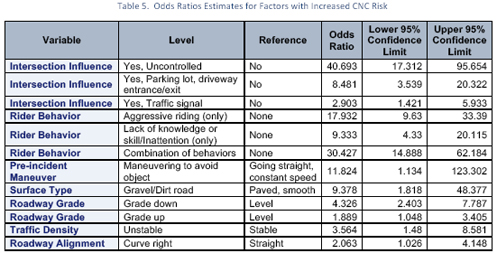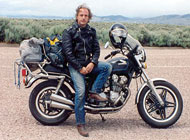Digging Into Results Of Naturalistic Study

This chart from the report shows how much certain conditions or actions increase risk. (Source: Motorcycle Safety Foundation)
As noted previously, the Motorcycle Safety Foundation (MSF) has released the results of its naturalistic motorcycle crash study. Here are some interesting items from that report.
I would guess that the findings the MSF considers important to work into their rider training curriculum could be considered the most relevant. Toward the end of the report there is a section, “Application of Findings,” where they briefly state the issue and then list the finding that suggest more emphasis might be needed in training. I’m going to abbreviate this considerably. If you want to read it all you’ll find the report here.
- Changing direction requires special attention / Riding in a right curve doubles the risk of a crash or near-crash compared to riding on a straight roadway.
- Emphasis on the importance of appropriate speed in curve maneuvers / Study results indicate that excessive speed is a factor in 45% of the events.
- Crashes, if they ever happen, occur mostly in curves and at intersections / The risk of crashes
and near-crashes are increased at various types of intersections: traffic signaled intersections (nearly 3 times), parking lot/driveway intersections (8 times), and intersections uncontrolled in the rider’s direction (40 times). - There is rarely a single cause of any crash / Factors that increase risk include locality, intersections, the type of road surface, traffic flow, roadway grade, and roadway alignment; practicing under these conditions, riding with extra vigilance, or just avoiding the risky situations will decrease one’s chance of being involved in a crash.
- Use your eyes and mind to determine how and when to adjust position as situations unfold / having to maneuver to avoid an object increases the crash/near-crash risk by nearly 12 times.
- Running off the road accounts for many crashes / 67% of all single-vehicle crashes and near-crashes involved curve negotiation, and 63% of those were run-off-road or lane line crossing cases.
- Special consideration for starting on a hill / riding on an uphill grade doubles the risk of crash/near-crash, and riding on a downhill grade increases this risk four-fold.
- Types of road surfaces to be aware of, and how to react to them / Riding on a gravel or dirt road is related to 9 times the risk of crash/near-crash involvement than riding on paved, smooth roads.
Of course, we already know these different situations involve greater risk but this study puts some numbers to them as to just how much riskier they are than just going straight on a smooth road under good conditions. All good information to factor into your riding strategy.
Biker Quote for Today
A bad day just makes an evening ride feel that much better.
